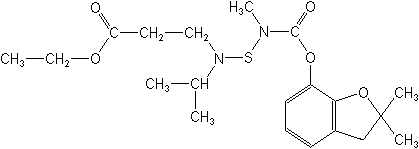-
Common NameBenfuracarb
-
中文通用名丙硫克百威
-
IUPACethyl N-[2,3-dihydro-2,2-dimethylbenzofuran-7-yloxycarbonyl(methyl)aminothio]-N-isopropyl-
b-alaninate -
CAS2,3-dihydro-2,2-dimethyl-7-benzofuranyl 2-methyl-4-(1-methylethyl)-7-oxo-8-oxa-3-thia-2,4-diazadecanoate; ethyl N-[[[[(2,3-dihydro-2,2-dimethyl-7-benzofuranyl)oxy]carbonyl]methylamino]thio]-N-(1-methylethyl)-
b-alaninate -
CAS No.82560-54-1
-
Molecular FormulaC20H30N2O5S
-
Molecular Structure
-
Physical PropertiesMolecular weight:410.5; Physical form:Viscous reddish-brown liquid. Density:1.1493 (20 °C); Flash point:114 °C (closed cup); Vapour pressure:<1 ?/SYM> 10-2 (20°C, gas saturation method); Partition coefficient(n-octanol and water):logP = 4.22 (25 °C); Solubility:In water 7.74 /l ( 6.5, 20 °C). In benzene, dichloromethane, ethanol, acetone, hexane, xylene and ethyl acetate >1000 g/l (20 °C).; Stability:Stable in neutral and weakly basic media, but unstable in acidic and strongly basic media. Decomposes at 227 °C.;
-
ToxicologyOral:Acute oral
50 for male rats 222.6, female rats 205.4, mice 175, dogs 300 / . Percutaneous:Acute percutaneous 50 for rats >2000 /kg. Non-irritant to skin, slightly irritant to eyes (rabbits). Non-sensitising to skin (guinea pigs). Inhalation: 50 (4 h) for rats 0.34 /l air. -
Environmental ProfileEcotoxicology:
Bees:50 (topical) 0.29 mg/g.Birds:Acute oral 50 for hens 92 / .Daphnia: 50 (3 h) >10 /l.Fish: 50 (48 h) for carp 0.65 /l.
Environmental fate:
Animals:In rats, benfuracarb is metabolised rapidly and almost completely excreted in the urine and faeces within 7 days. Major metabolites in the faeces are carbofuran, carbofuran phenol, 3-hydroxycarbofuran, 3-hydroxyphenol, and 3-ketophenol. Urinary metaboliteSoil:50 in soil is c. 4-28 h. Under upland conditions, benfuracarb is decomposed to carbofuran, while under flooded conditions, carbofuran phenol is also found as a major degradation product.Plant:In plants, N-S bond cleavage occurs as the initial step, giving rise to carbofuran, which is subsequently metabolised to 3-hydroxycarbofuran. The principal hydrolytic products are carbofuran phenol and 3-hydroxy- and 3-ketophenol, all present in -
Transport InformationSignal Word:CAUTION;
Hazard Class:III(Slightly hazardous)
Porduct NewsMore
Orthosulfamuron boosts sugarcane production, study finds
Glyphosate price plummets 40% in one year in Argentina
Indian govt stops imports of herbicide Glufosinate priced below Rs 1,289 per kg
Carbendazim fungicide wins victory in Brazilian Parliament
Corteva presents new pre-emergent herbicide Linear for sugarcane in Brazil
Picloram Triclopyr Aminopyralid
Revolutionizing disease prevention: BASF launches new rice fungicide Cevya® in China
Thiamethoxam is allowed again in Brazil by a judicial decision
Bayer develops alternative to glyphosate herbicide
Related CompaniesMore
Hunan Haili Chemical Industry Co., Ltd.
Country: China
Carbofuran Carbosulfan Propoxur Fenobucarb/BPMC lsoprocarb/MIPC Carbaryl Methomyl Dimethoate Pirimiphos-methyl Thiodicarb Thiophanate-methyl

 0
0 Subscribe
Subscribe
